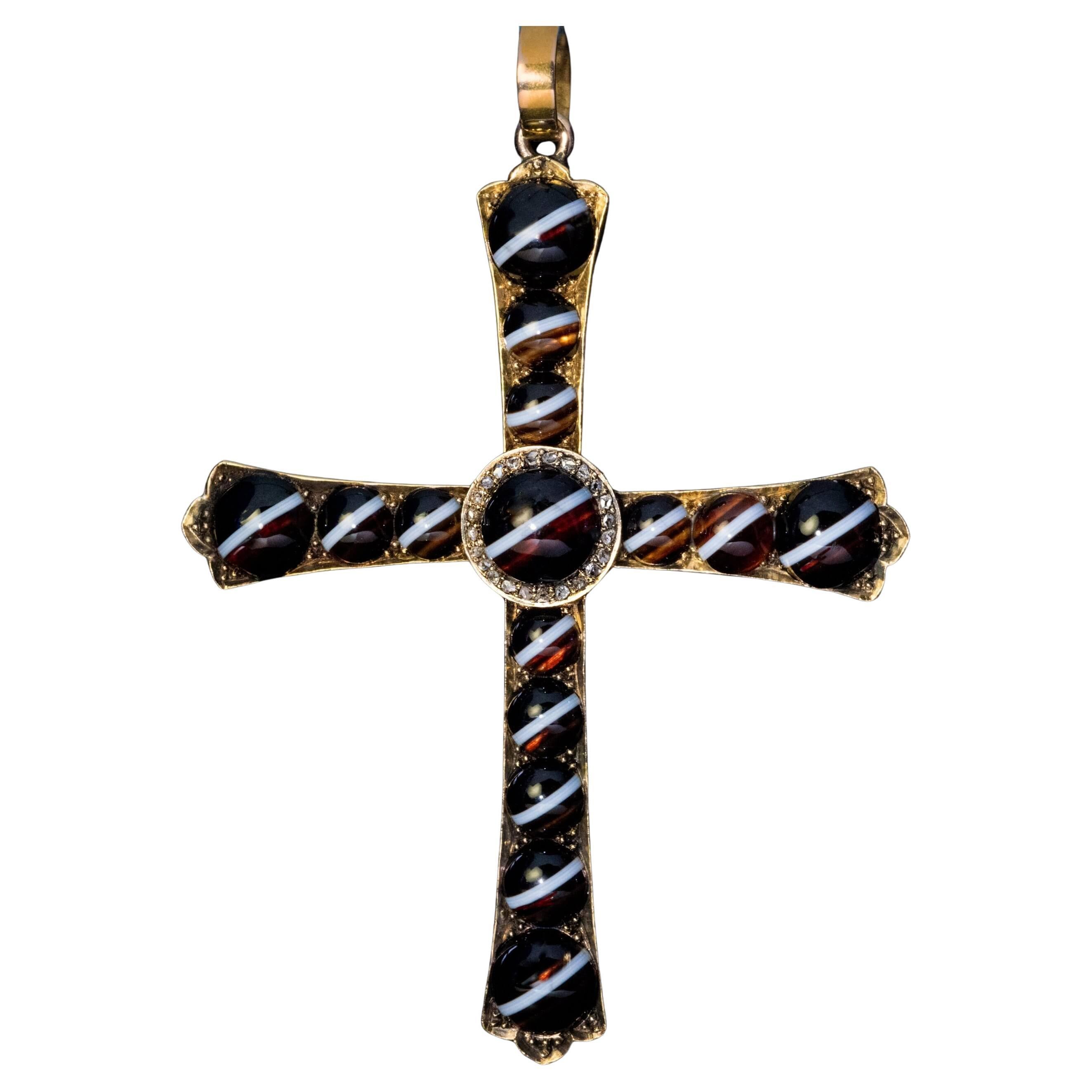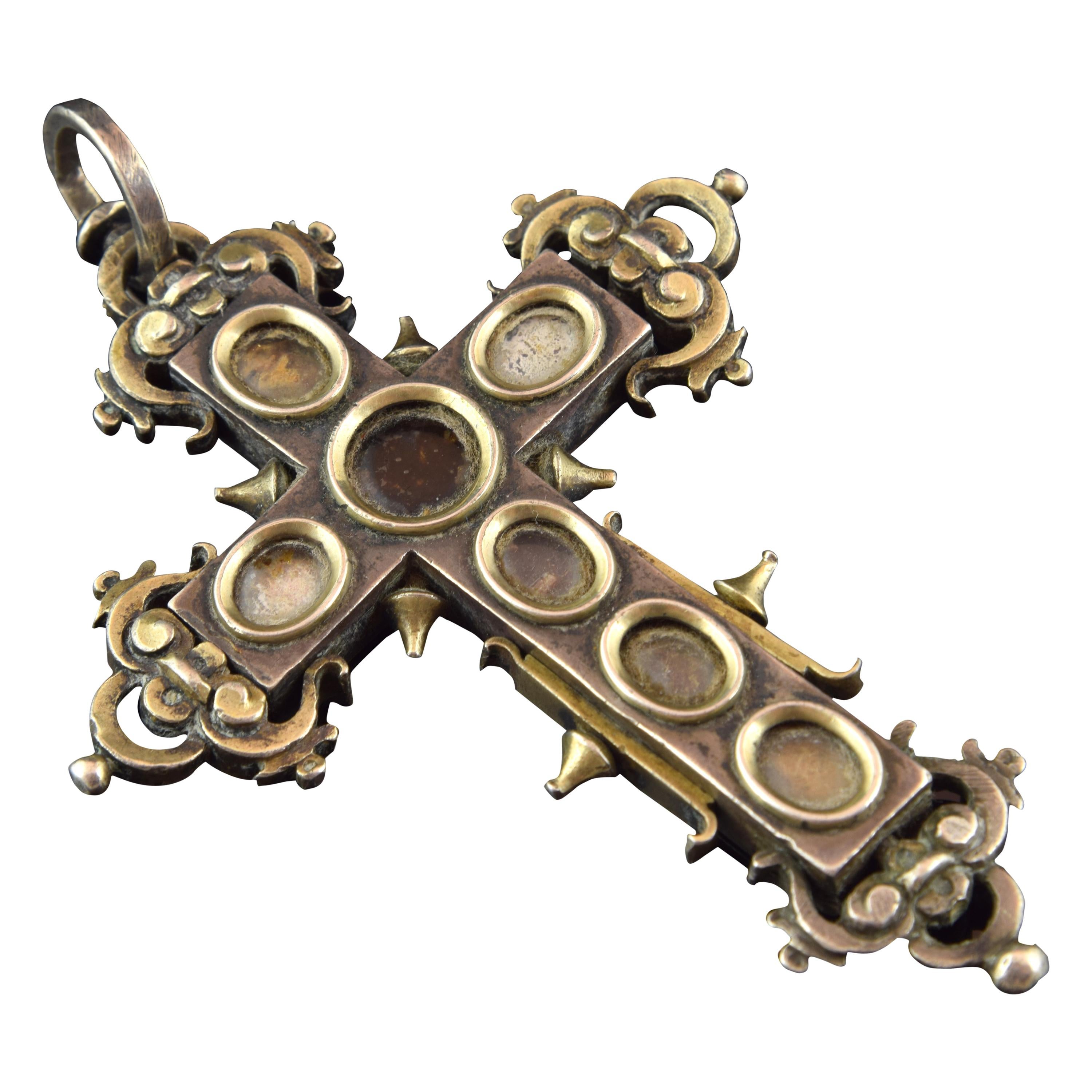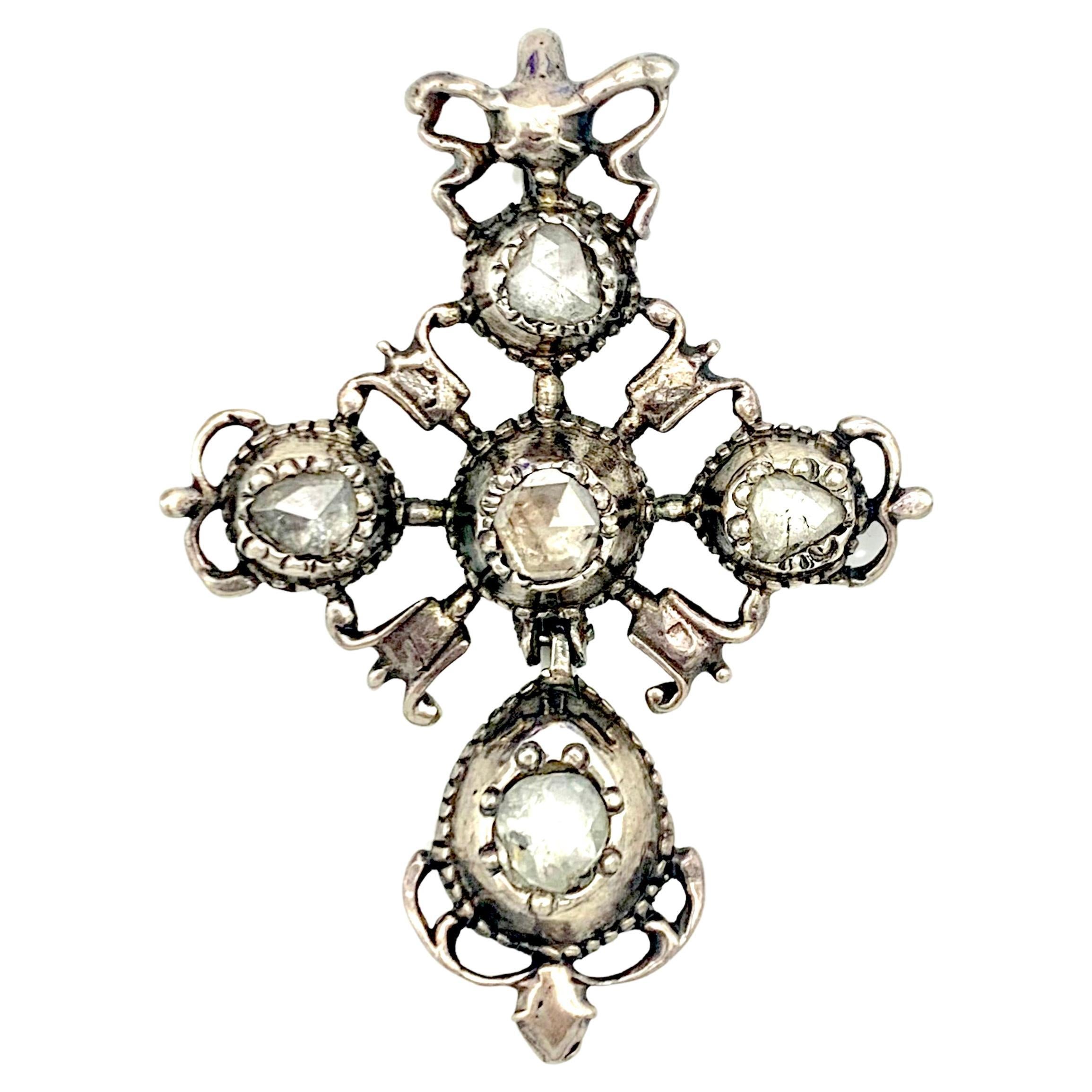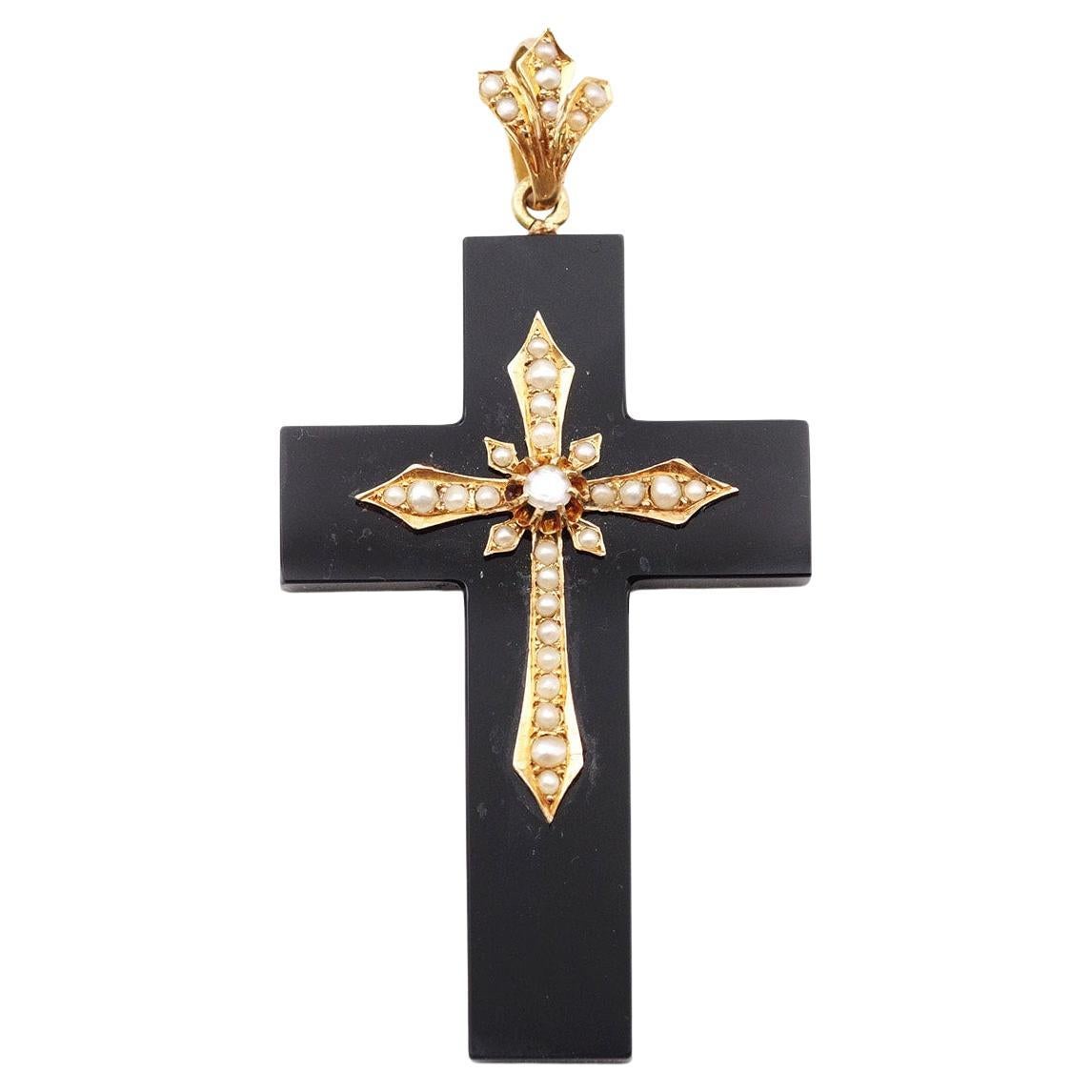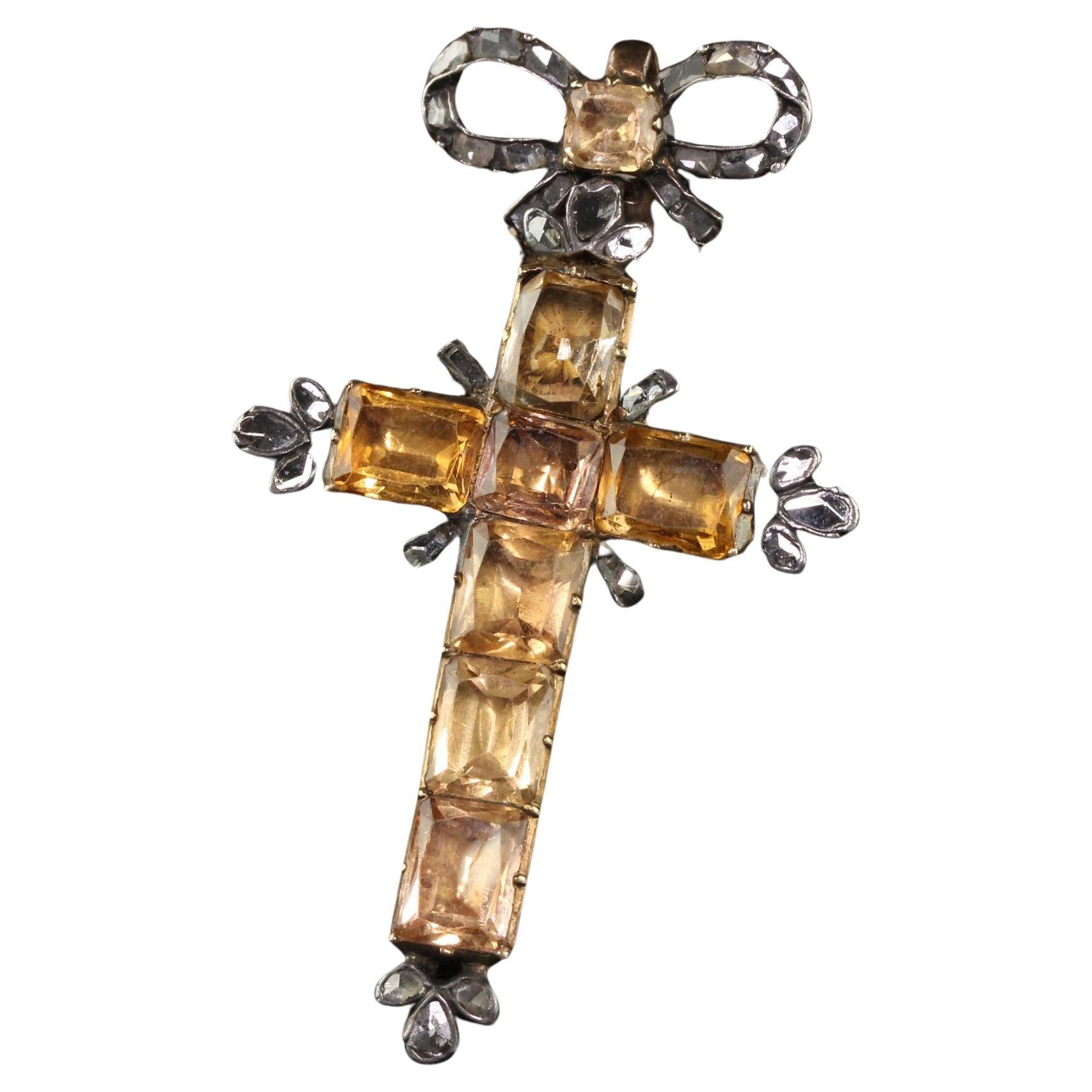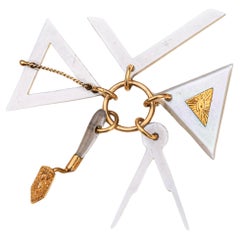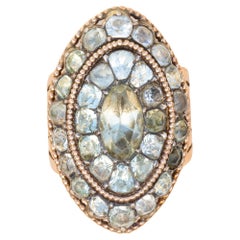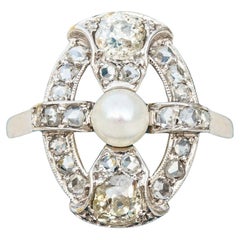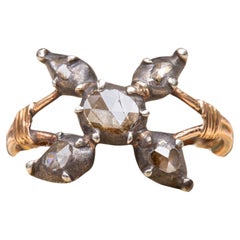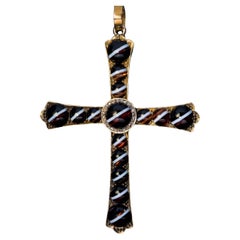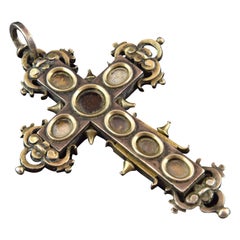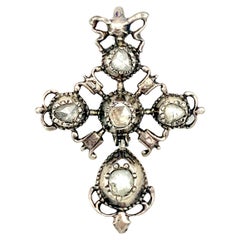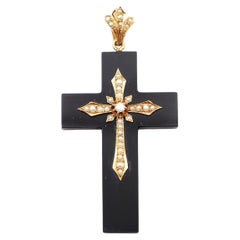Items Similar to Rare Antique 17th Century Carved Rock Crystal Cross Pendant Reliquary Religious
Want more images or videos?
Request additional images or videos from the seller
1 of 9
Rare Antique 17th Century Carved Rock Crystal Cross Pendant Reliquary Religious
$4,473.35
£3,250
€3,809.52
CA$6,106.98
A$6,793.76
CHF 3,561.37
MX$83,018.09
NOK 45,349.66
SEK 42,690.43
DKK 28,436.65
Shipping
Retrieving quote...The 1stDibs Promise:
Authenticity Guarantee,
Money-Back Guarantee,
24-Hour Cancellation
About the Item
This exceptional, rare cross pendant dates from circa 1650, crafted in either Spain or France. Made from pure rock crystal, the pendant showcases the gemstone's unrivalled clarity, reminiscent of mountain spring water. Each arm is faceted with bevelled edges and capped in high-karat gold with granule detailing—a typical feature of crosses from this period. The cross's centre is tightly wrapped in gold, ensuring the secure setting of the crystals.
Rock crystal is a natural gemstone historically revered for its purity. Since the Middle Ages, it symbolised spiritual cleanliness and was frequently used in reliquaries and ecclesiastical objects. Its presence in religious items like this cross reflects its enduring association with faith and devotion.
This pendant measures an impressive 6cm by 5.5cm and weighs 7.2 grams. All crystals are securely set, with one arm slightly angled, adding to its handmade charm and historic authenticity. The six-sided crystals are approximately 0.7 cm thick.Although unmarked, the gold tests as 18K gold.
For comparison, an earlier example of a rock crystal cross from Spain (c. 1600) is housed in the Victoria & Albert Museum. This exceptional, rare cross pendant dates from circa 1650, crafted in either Spain or France. Made from pure rock crystal, the pendant showcases the gemstone's unrivalled clarity, reminiscent of mountain spring water. Each arm is faceted with bevelled edges and capped in high-karat gold with granule detailing—a typical feature of crosses from this period. The cross's centre is tightly wrapped in gold, ensuring the secure setting of the crystals.
Rock crystal is a natural gemstone historically revered for its purity. Since the Middle Ages, it symbolised spiritual cleanliness and was frequently used in reliquaries and ecclesiastical objects. Its presence in religious items like this cross reflects its enduring association with faith and devotion.
This pendant measures an impressive 6cm by 5.5cm and weighs 7.2 grams. All crystals are securely set, with one arm slightly angled, adding to its handmade charm and historic authenticity. The six-sided crystals are approximately 0.7 cm thick.Although unmarked, the gold tests as 18K gold.
For comparison, an earlier example of a rock crystal cross from Spain (c. 1600) is housed in the Victoria & Albert Museum.
- Metal:
- Stone:
- Stone Cut:
- Weight:7.27 g
- Dimensions:Width: 218.71 in (5,555 mm)Length: 238.59 in (6,060 mm)
- Period:Mid-17th Century
- Date of Manufacture:16501650
- Condition:
- Seller Location:London, GB
- Reference Number:Seller: 10160101601stDibs: LU2845224962752
About the Seller
5.0
Vetted Professional Seller
Every seller passes strict standards for authenticity and reliability
Established in 2019
1stDibs seller since 2022
46 sales on 1stDibs
- ShippingRetrieving quote...Shipping from: London, United Kingdom
- Return Policy
Authenticity Guarantee
In the unlikely event there’s an issue with an item’s authenticity, contact us within 1 year for a full refund. DetailsMoney-Back Guarantee
If your item is not as described, is damaged in transit, or does not arrive, contact us within 7 days for a full refund. Details24-Hour Cancellation
You have a 24-hour grace period in which to reconsider your purchase, with no questions asked.Vetted Professional Sellers
Our world-class sellers must adhere to strict standards for service and quality, maintaining the integrity of our listings.Price-Match Guarantee
If you find that a seller listed the same item for a lower price elsewhere, we’ll match it.Trusted Global Delivery
Our best-in-class carrier network provides specialized shipping options worldwide, including custom delivery.More From This Seller
View AllVictorian Masonic Mother of Pearl Charms
Located in London, GB
A very rare mid-19th century French masonic mother of pearl charm pendant.
It is truly remarkable how this particularly fragile gold and mother of pearl pendant has survived in such pristine condition for all these years.
The charm pendant features 5 different motifs associated with Freemasonry including the shovel, all-seeing eye, compass, square and scales. They have all been crafted in gold and hand carved mother of pearl. The individual pendants can be easily added or removed as the bail is actually a split ring which opens up.
The pendant weighs 1.77 grams. The gold is unmarked but tests as 15K gold. It measures approximately 2cm in length.
A fantastic and coveted addition for any collector of rare and antique masonic jewellery.
Category
Antique Mid-19th Century Pendant Necklaces
Materials
15k Gold
Rare 18th Century Portuguese Cluster Ring Minas Novas Rock Crystal Antique
Located in London, GB
A rare Portuguese 18th century ‘minas novas’ rock crystal cluster ring, circa 1770. A lovely example of Georgian period Portuguese jewellery, this m...
Category
Antique Late 18th Century Portuguese Georgian Cluster Rings
Materials
Rock Crystal, 15k Gold
Antique French Art Deco Diamond Ring Platinum Old Cut Unusual Engagement
Located in London, GB
A superb example of early 20th-century French jewellery, this Art Deco period ring truly embodies the elegance and subtle symbolism of the jewels from this era. Crafted in platinum t...
Category
Vintage 1920s Art Deco Engagement Rings
Materials
Diamond, Cultured Pearl, Platinum
Scarce Antique Georgian Rose Cut Diamond Flower Floral Cluster Ring Rare Design
Located in London, GB
A superb antique Georgian diamond cluster ring, circa 1780-1820.
The silver-topped gold bezel exhibits a floral cluster of rose cut diamonds, all in closed-back rubover silver sett...
Category
Antique Late 18th Century Dutch Georgian Cluster Rings
Materials
Diamond, 18k Gold
Antique Mid-19th Century, French 18K Agate and Rose Cut Diamond Cluster Ring
Located in London, GB
This stunning antique cluster ring was made in France and dates to around the mid 19th century, circa 1860. In the centre rests a smooth banded agate in an open back setting, encircled by a halo of rose cut diamonds in closed-back, cutdown silver settings with a combined approximate weight of 0.15 carats. The ring has a decorative pierced gallery in the form of crescents and a solid semi-circular shank. The shoulders are decorated with two applied fleur-de-lis, each set with rose cut diamonds in silver settings.
The main colour of the milky agate is a creamy-brown hue with a darker brown band on one side. The diamonds are rose cut, the triangular facets of these cuts were very popular during the Georgian and Victorian periods as they glistened more beautifully in candlelight than any other cut.
This elegant ring sits flat on the finger, the stones are secure in their settings and the ring is in superb condition despite its significant age, a truly rare find!
UK size U / US size 10, 5.44g, French ’tête...
Category
Antique Mid-19th Century French Victorian Cluster Rings
Materials
Agate, Diamond, 18k Gold
Important 19th Century Royal Siam Diamond Cluster Ring Museum-Grade Thai
Located in London, GB
An outstandingly rare mid-19th century royal Siam diamond cluster ring, made by the royal goldsmiths of the court of Bangkok.
This is an extremely fine example of the jewellery commissioned and subsequently bestowed by the Kings of Siam, principally to be worn by participants in royal and aristocratic life-cycle ceremonies in the courts of Bangkok. In the mid-19th century, King Mongkut (Rama IV) of Siam also commissioned the courtly jewellers to create a number of faithful replicas of these ceremonial jewels to be offered as gifts to diplomatic families, important visitors and to Heads of State across the world when re-establishing diplomatic relationships. One such example (which is remarkably similar to the present ring) resides in the museum of the Château de Fontainebleau (item F1518C) where it was given as a gift from King Mongkut to Napoléon-III on the important ambassadorial visit of 1861 (see photos for a side by side comparison).
Ceremonial Use:
During the 19th century, many rings were made every year by the royal jewellers for ceremonial use. Examples of these lavish cluster rings being worn for these life-cycle ceremonies can be seen on old photos and paintings of the Royal Tonsure Ceremony, also known as ‘the cutting of the top-knot’ ceremony, which marked the transition from childhood into adulthood for all of the (many!) sons and daughters of the Siam royal family.
The huge expansion in the number of royals in 19th century Siam stemmed from Kings Mongkut (Rama IV) and Chulalongkorn (Rama V) being highly polygamous. They had a joint total of 124 wives and 159 royal children, each requiring their own ceremonial regalia and princely jewels. As a result, Bangkok became home to some incredibly skilled goldsmiths in this period. The Tonsure ceremony was performed by the King, and lasted three days and three nights. All of the royal children would be dressed in the most splendid costumes and adorned with a vast amount of jewels on several parts of the body. Their costumes and jewels differed according to their title and rank. Diamonds for instance, would be bestowed to the highest ranking noble children. The royal children were allowed to keep their regalia and jewels as a present on entering adulthood to indicate their social status among society.
Over the years, these royal jewels have been dispersed across the many noble families, with currently only a few important pieces remaining in the royal collection. Today, the number of royals in Thailand is contracting as the country follows the Chinese nobility system whereby with each generation the noble rank of a family decreases by one ranking so that eventually the majority of descendants will lose their noble status completely. This loss of royal privilege, coupled with the dilution of wealth has meant that items such as this ring become available on the open market. Following the end of the absolute monarchy in Thailand in 1932, many members of the royal family relocated to Europe and as a consequence, princely Thai items can occasionally be found in the European art market.
Gift Exchange:
In Siam culture, great importance is placed on the ancestral process of gift-exchange. During the reign of King Mongkut, close relationships with some powerful countries were cultivated in order to hold the balance of power and to save Siam from being colonised. The King used gift-exchange to establish diplomatic relations with other heads of state around the world, as well as with other kings, princes and sultans closer to home. He sent troupes of ambassadors to England (1857) and France (1861) with seemingly endless amounts of trunks filled with lavish gifts in order to dazzle the heads of state with the extraordinary quality and variety of Siam craftsmanship.
These gifts consisted of faithful replicas of the Royal Regalia and objects belonging to the King himself; items and jewellery worn by him on his Tonsure ceremony and on his coronation day. Enormous time and effort was required by the Siam court to assemble these numerous gifts, as they emanated from the very same royal goldsmiths and courtly craftsman who had made the original ceremonial items.
The most famous of these ceremonies took place at the Chateau de Fontainebleau in 1861. The painting by Jean-Léon Gérôme that immortalised the event prominently features the most spectacular of these gifts. Among the 150 gifts presented to Napoléon-III by the Siam ambassadors were two diamond-set rings, both of which are on display in the Musée du Chateau de Fontainebleau (item no. F1518C and F1519C). One of these rings is a rose cut diamond cluster and bears a striking resemblance to the ring we are offering. According to Bruley (2011), this ring, presented to Napoleon-III, was a faithful replica of the ring worn by King Mongkut on his own coronation day in 1851, which now resides in the Pavilion of Royal Regalia in Thailand.
The Ring:
From whichever angle the present ring is viewed, it is a masterpiece of design and a testament to the ingenuity and craftsmanship of the Siam royal goldsmiths. The bezel head is composed of two layers, the uppermost, containing the large triangle shaped table-cut diamond, is riveted to the main body of the ring. The second layer of the cluster is set with a further eight rose cut diamonds and this section allows for small rotation, typical of Siam jewellery...
Category
Antique Mid-19th Century Thai Victorian Cluster Rings
Materials
Diamond, 22k Gold
You May Also Like
Large Antique Banded Agate Diamond Gold Cross Pendant
Located in Chicago, IL
Circa 1880
This unusual, one of a kind cross pendant is finely crafted in 14K gold. It is set with fifteen perfectly matched cabochon cut banded agates. The center stone is encircl...
Category
Antique 1880s Victorian Pendant Necklaces
Materials
Agate, Diamond, White Diamond, Gold
Reliquary Cross Pendant, Silver, Glass, 17th-18th Century
Located in Madrid, ES
Devotional pendant made in silver with a Latin cross shape, decorated on the outside with simple scrolls, spikes, pearls and other elements of classicist inspiration, as well as a ri...
Category
Antique 18th Century European Neoclassical Religious Items
Materials
Silver
Antique 18th Century Old Cut Rose Diamond Cross St. Andrews Cross Pendant Silver
Located in Munich, Bavaria
This beautiful and original silver cross was handcrafted in the second half of the 18th century, in the 1770's. The jewel is set with old mine rose diamonds in closed settings. From a bow shaped slide a cross is suspended. The large drop shaped element at the bottom of the cross is articulated. Four arrow shafts arranged as an X or St. Andrews cross...
Category
Antique 1770s French Pendant Necklaces
Materials
Diamond, Silver
Mourning onyx cross pendant in 18k gold, French Victorian large cross onyx
Located in PARIS, FR
Mourning onyx cross pendant in 18 karat gold. 19th-century cross-shaped pendant, decorated with gold motifs set with fine half-pearls and centered with a pearl set by eight prongs. T...
Category
Antique 1860s French Late Victorian Pendant Necklaces
Materials
Onyx, 18k Gold
Bohemian Crystal Pontifical Crucifix
Located in New York, NY
Faceted crystal crucifix from Bohemia circa 1900. The faceted crystals are set into darkened silver gilt plate with a decorative multi pronged edge. B...
Category
Antique Early 1900s Czech Late Victorian Pendant Necklaces
Materials
Crystal, Gold Plate, Silver Plate, Gilt Metal, Pinchbeck
Antique Georgian 18K Gold and Silver Citrine Rose Cut Diamond Cross Pendant
Located in Great Neck, NY
Beautiful Antique Georgian 18K Gold and Silver Citrine Rose Cut Diamond Cross Pendant. This incredible Georgian cross is crafted in 18k ...
Category
Antique Early 1800s Georgian Pendant Necklaces
Materials
Citrine, Diamond, Gold, 18k Gold, Yellow Gold, Silver
More Ways To Browse
Carved Rock Crystal Jewelry
Rock Crystal Cross
17th Century French Jewelry
Reliquary Pendant
Antique Reliquary Jewelry
Tiffany 1837 Necklaces
Tiffany T1 Necklace
Van Cleef Diamond Alhambra Necklace
Van Cleef Malachite
Victorian Citrine Necklace
Victorian Seal Fob
Vintage Crystal Necklace Vintage And Antique Jewellery
Whistle Pendant
14k Jade Heart
18k Gold Augis Love Pendant
18k Yellow Gold Cherub Pendant
18k Gold Charm Dog
325 Gold
